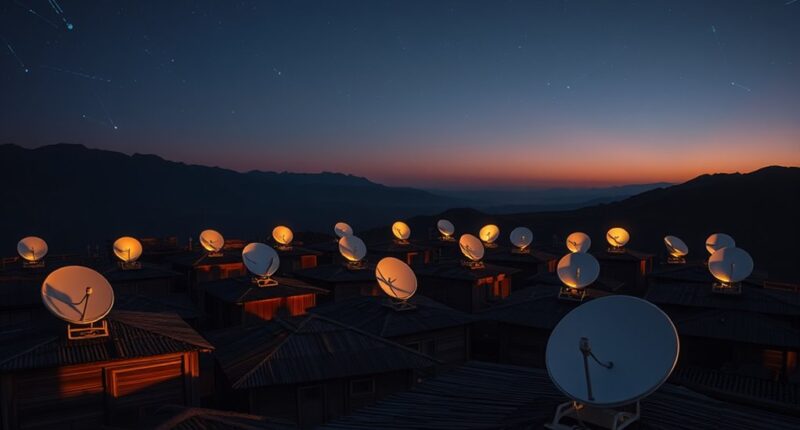Starlink brings high-speed, low-latency satellite internet to remote and underserved areas, helping you stay connected where traditional broadband can’t reach. It uses a constellation of low Earth orbit satellites for faster, more reliable service, with easy setup that only needs a dish and clear sky. While weather might cause occasional hiccups, overall it offers a dependable connection. Keep exploring to discover how Starlink can bridge your digital gap and improve your online experience.
Key Takeaways
- Starlink provides high-speed internet coverage in remote and rural areas where traditional broadband is limited.
- Its constellation of low Earth orbit satellites reduces latency, enabling activities like streaming and gaming.
- Installation is simple, requiring only a dish and clear sky, making it suitable for hard-to-reach locations.
- The system ensures secure data transmission through robust encryption, protecting user privacy.
- Scalability allows Starlink to expand coverage and improve connectivity in underserved regions over time.

Have you ever wondered how to get fast, reliable internet in remote or rural areas? If so, Starlink satellite internet might just be the solution you’ve been searching for. Unlike traditional broadband, which often struggles to reach isolated locations due to the high costs of infrastructure, Starlink uses a constellation of low Earth orbit satellites to provide coverage almost anywhere. This innovative approach means you can connect even in places where fiber optic cables or cell towers are absent. However, understanding satellite latency is essential when considering this service. Because the satellites orbit much closer to Earth than traditional geostationary satellites, Starlink achieves markedly lower latency, making activities like video calls, gaming, or streaming more seamless and responsive. Instead of experiencing frustrating delays, you get a smoother internet experience that rivals terrestrial connections.
Starlink’s low Earth orbit satellites deliver fast, low-latency internet even in remote, underserved areas.
But with new technology, concerns about network security naturally arise. When you’re relying on satellite internet, your data travels through various channels, so it’s imperative to understand how secure your connection is. Starlink employs robust encryption methods to safeguard your information from potential threats. This encryption helps prevent unauthorized access and ensures that your sensitive data remains private as it moves between your device and the satellite network. Additionally, Starlink continually updates its security protocols to address emerging vulnerabilities, keeping your connection safe from cyberattacks. While no system is entirely invulnerable, Starlink prioritizes network security to give users confidence that their online activities are protected. It’s also important to recognize that satellite technology plays a crucial role in bridging the digital divide, providing internet access to underserved areas where traditional infrastructure is challenging to deploy.
Another advantage of Starlink is its quick setup. You don’t need to wait for building new infrastructure or waiting months for service providers to install cables. With a simple dish and a clear view of the sky, you can be online in a matter of minutes. This ease of installation is especially important in remote regions where technical support may be limited. Plus, Starlink’s network is designed to be scalable, meaning it can expand to serve more users as demand grows, guaranteeing reliable coverage over time.
Of course, satellite internet isn’t perfect. Factors like weather conditions can temporarily affect signal quality, but overall, the service provides a dependable connection that bridges the digital divide. If you’re tired of slow or unreliable internet in rural areas, Starlink offers a compelling alternative. Its low satellite latency ensures your online activities feel natural and instantaneous, while advanced security measures protect your data from cyber threats. So, whether you’re working remotely, streaming movies, or staying connected with loved ones, Starlink helps you stay online wherever you are, breaking down the barriers of distance and location.
Frequently Asked Questions
How Does Starlink Compare in Speed to Traditional Broadband?
You’ll find Starlink offers comparable speeds to traditional broadband, with download rates often between 50-200 Mbps. While satellite latency is higher—around 20-40ms—it’s improving with technology updates. When considering bandwidth comparison, Starlink provides steady performance even in remote areas, making it a solid alternative. Although you might experience slightly more delay than fiber or cable, its fast speeds and lower latency make it a competitive option.
What Are the Environmental Impacts of Starlink Satellites?
You might wonder about Starlink’s ecological effects, and while it offers connectivity, it does come with some concerns. The satellites contribute to space debris, raising worries about space clutter. Additionally, they can affect ecological systems by reflecting sunlight and potentially disturbing wildlife. While these impacts are relatively small compared to traditional infrastructure, it’s important to evaluate their long-term environmental footprint and explore ways to minimize space debris and ecological disruption.
Can Starlink Be Used for Emergency Communications?
Yes, you can use Starlink for emergency communications. It plays a crucial role in emergency preparedness and disaster response by providing reliable internet when traditional networks fail. During natural disasters, Starlink helps coordinate rescue efforts, share information quickly, and reconnect affected communities. Its fast deployment and global coverage make it an essential tool for ensuring continuous communication when every second counts in emergencies.
What Is the Lifespan of a Starlink Satellite?
Imagine a satellite gracefully orbiting, resilient against space’s harshness—that’s the lifespan of a Starlink satellite, typically around 5 to 7 years. Its durability depends on factors like radiation, temperature extremes, and orbital debris. You can expect these satellites to perform reliably during that time, but eventual wear and tear mean they’ll need replacement or upgrades to keep your internet connection steady.
How Does Starlink Handle Regulatory Challenges Worldwide?
You should know that Starlink handles regulatory challenges worldwide by prioritizing regulatory compliance and obtaining satellite licensing in each country. They actively work with local authorities to meet legal requirements, ensuring their satellites operate within permitted spectrum bands. This proactive approach helps them navigate complex regulations, reduce delays, and expand service globally, making satellite licensing and compliance integral to their international growth strategy.
Conclusion
With over 2,300 satellites orbiting Earth, Starlink has already provided internet access to over 1 million people in remote areas. This innovative network is transforming lives by bridging the digital divide, allowing you to connect from even the most isolated locations. As Starlink continues to expand, more people will enjoy fast, reliable internet. Imagine the possibilities when distance no longer limits your access to information, education, and opportunities—Starlink is truly changing the game.








